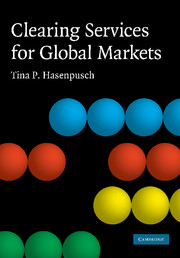 Clearing Services for Global Markets
Clearing Services for Global Markets Book contents
- Frontmatter
- Contents
- List of figures
- List of abbreviations
- Acknowledgements
- Foreword
- 1 Introduction
- 2 Setting the stage – definitions and industry setting
- 3 Defining the core issues – efficiency and network strategies
- 4 Collecting empirical insights – introduction to the empirical study
- 5 Analysing costs of derivatives clearing – transaction cost studies
- 6 Exploring theoretical basics – scale effects in clearing
- 7 What theory reveals – framework for efficiency analysis of network strategies
- 8 Checking theory against reality – case studies of network strategies
- 9 Quantifying the efficiency impact – European network strategies
- 10 Introducing the future network economy – development of the clearing industry
- 11 Summary, discussion and recommendations for future research
- Appendices
- Bibliography
- Index
2 - Setting the stage – definitions and industry setting
Published online by Cambridge University Press: 19 January 2010
- Frontmatter
- Contents
- List of figures
- List of abbreviations
- Acknowledgements
- Foreword
- 1 Introduction
- 2 Setting the stage – definitions and industry setting
- 3 Defining the core issues – efficiency and network strategies
- 4 Collecting empirical insights – introduction to the empirical study
- 5 Analysing costs of derivatives clearing – transaction cost studies
- 6 Exploring theoretical basics – scale effects in clearing
- 7 What theory reveals – framework for efficiency analysis of network strategies
- 8 Checking theory against reality – case studies of network strategies
- 9 Quantifying the efficiency impact – European network strategies
- 10 Introducing the future network economy – development of the clearing industry
- 11 Summary, discussion and recommendations for future research
- Appendices
- Bibliography
- Index
Summary
The purpose of this chapter is to set the stage for the research conducted in this study. As relevant definitions are a prerequisite for any thorough analysis, the first step is to clarify the terminology used throughout this study (section 2.1). Next, the value-added of clearing for individual market participants (microeconomic view) and for capital markets as a whole (macroeconomic view) and according to different asset classes (cash equities and derivatives) is outlined in section 2.2.
At this juncture, the so-called ‘Value Provision Network’ is introduced to illuminate the structural set-up of the clearing industry, including the different layers of access to the market infrastructure (section 2.3). The network consists of the clearing house and market participants, both with direct (the so-called ‘clearing members’) and indirect access to the CCP (the so-called ‘non-clearing members’), whose access to the clearing house takes place through intermediaries). An understanding of the Value Provision Network is critical for grasping the true underlying mechanisms of the clearing industry, which influence the structural set-up and competitive dynamics relevant for the future development of the industry.
Once this has been provided, the different stakeholders in clearing are introduced (section 2.4), followed by an explanation and comparison of the current clearing industry structures in Europe and the United States (section 2.5). A final step provides a summary of this chapter (section 2.6).
- Type
- Chapter
- Information
- Clearing Services for Global MarketsA Framework for the Future Development of the Clearing Industry, pp. 16 - 72Publisher: Cambridge University PressPrint publication year: 2009


